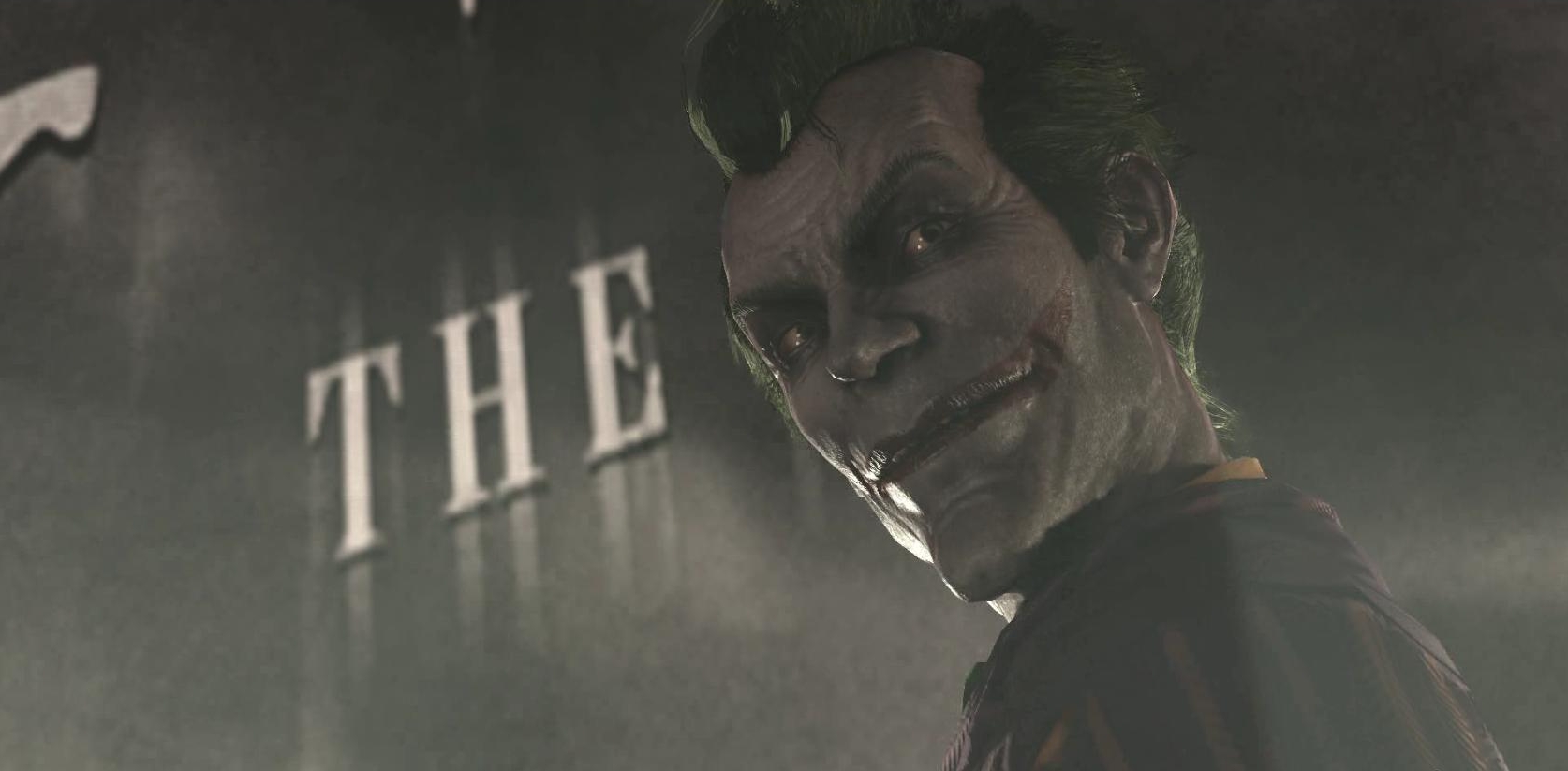Our Verdict
Bat-brawling shows wear and Batmans a charisma void, but the freedom and depth of the open world are mesmerising.
PC Gamer's got your back
We've seen a wide range of Batflavours over the years: campy Batman, angsty Batman and, thanks to writer Frank Miller's increasing mental derailment, batshit Batman.
Here we get straight-down-theline Batman. Arkham City captures his technique, but lets some of his character slip away into the night. For a hi-tech super-ninja spandex vigilante, he is peculiarly bland.
Luckily, the Dark Knight is not a man of words, but of deeds – and this game, like its predecessor, has them nailed. Batman zip-lines, grapnels and swoops between the moonlit rooftops of this open-world city, emerging from the shadows to hammer clusters of goons. He even finds time for a spot of light puzzling and the odd platforming challenge.
The action is magicked straight from the films and comics, where discretion and detection are as important as slamming Bat-fists through the faces of the criminally insane. Well, almost as important. Batman in motion is awesome to behold: he sneaks and swoops with a deft mo-cap mastery, and annihilates room after room of thuggish mental patients with fluid violence, catching and deflecting blows in a storm of semi-procedural devastation.
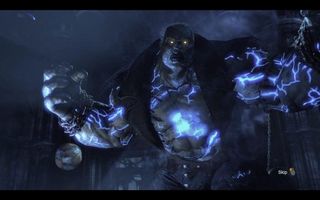
It's just a pity that whenever he opens the flap in his gigantic chin he proves to be a right old Bat-chump. The world's greatest detective only ever seems adept at detecting the extremely obvious, and when he tries his hand at humour Catwoman tells him to shut up – as well she should. It's wise to leave the jokes to The Joker, who returns here wittier and more weasly than ever, although looking a little worse for wear after his encounter with the Titan serum at the end of Arkham Asylum.
The plot picks up some time after Batman's efforts mopping up the mass breakout at the maximum security mental asylum. The focus has now shifted to a larger portion of Gotham, which has been cordoned off and turned into an Escape From New York-style prison city. The why and how are barely worth acknowledging. The best Batman stories redeploy the iconic figures into larger allegories, and while this has a heavy-hitting narrative payoff in its last moment, it is otherwise nakedly a greatest hits. An excuse to cram together as many of Gotham's notorious evildoers as possible in one confined space and have Batman beat the XP out of them one by one.
It's not that confined though. Gone are the hubs of Arkham Island. Here we get an open world of guttering neon and gothic decay, a horseshoe of heavily compartmentalised urban squalor, surrounded by frigid water and barbed wire. It's not the most expansive of cityscapes in gaming, and any distinct character for its various locales struggles to emerge – probably because you spend more time flying over them than actually being in them.
Nonetheless, it's dense with diversions and detail, and Batman has full rein from the off, his utility belt immediately bristling with gadgetry that similar games would take hours to unlock. The grapnel and glide are not just ways to escape combat, but the thrilling means by which you turn the environment into your playground, soaring beneath the ghostly beam of the Bat Signal.
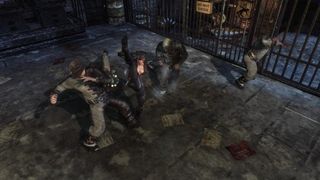
The central quest, when you find time for it, is a meaty thing, coming in at about 14 hours on my leisurely playthrough. It suffers a little from recycling its locations: flimsy plot elements ricochet you back and forth between the same villains' linear lairs, and although they change a little each time, revealing new routes and the scars of the battles fought within, it does end up feeling a little like rigmarole. Nonetheless, the pace, variety and craft of each lair is expertly managed. Whereas the preceding game made a starker distinction between fisticuffs and stealth sections, here there is a more gradual segue between the massive brawls, which now fill the screen with goons, and challenges where discretion is key.
This time, the introduction of new, deadlier opponents is rapid, and the game wastes little time before throwing guns into the mix. While Batman can soak up a clip or two, prolonged exposure to gunfire leads straight to the reload screen – where, aggravatingly, your failure is further mocked by a supervillain. Tossing a few smoke pellets down while you grapnel a gargoyle high above allows you to evade their aim – so long as they don't have infrared goggles – and the environments are riddled with interconnecting escape routes. Floor grates and ducts wind around each room, and there are plenty of low walls and drop points from which to launch an attack, before vanishing into the shadows again.
However, some fights leave you with no alternative but to dive in. As in the last game, such battles are a matter of restraint and timing. Enemies swarm you, readying themselves to deliver punches, kicks and stabs. You don't precisely choose how Batman attacks – you select the direction of his assault and unleash the procedural animation system, shattering his opponents with a freeflowing chain of blows and building up a combo meter that allows you to deliver permanent takedowns. Button mashing gets you some way with unarmed enemies, but as the bodies crowd in, knowing when not to attack quickly becomes just as important, giving yourself time between combos to tap the counter button and deflecting incoming fists to bone-shattering effect. Batman's solution for the criminally insane may be resolutely non-lethal, but he's not really big on care in the community either.
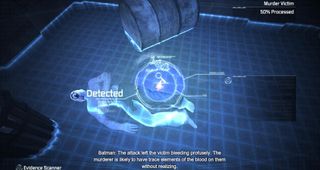
These punch-ups typically last twice as long as my excitement in them, but each is initially exhilarating to behold – particularly when it all goes right. It doesn't always go right. The battles take a lot out of your direct control in order to deliver flowing brutality, and the game's ability to guess your intent is often stretched to breaking point. When multiple types of enemies are introduced, each requiring a specific combo, the automation with which Batman selects his next opponent becomes critical. It's frustrating to accidentally vault into a cattleprod or waft your cape pointlessly over some inert goon, leaving the thug next to him free to heave a car door into your kidneys.
Even more aggravating are the game's attempts to help you in combat, popping up paragraphs of tutorial text in the centre of the screen. It's like suddenly succumbing to cataracts, mid-fight. The options to turn off such instructions are seemingly ineffective.
While the pointy-eared-one has several leads to pursue for the main mission, he has no shortage of distractions. Many of these are substantial quest chains in themselves, each focusing on a central villain. Deadshot has left plenty of perforated political prisoners for you to investigate using your detective vision to determine bullet trajectories and follow blood spatters, while Zsasz acts as the motive for a protracted point-topoint race, challenging Batman to reach the next ringing phone before he carves up another victim.
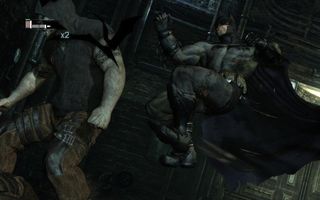
By far the most diverting, however, is The Riddler, who is once again neatly used to excuse a collectibles minigame. Riddler trophies dot the alleyways, rooftops and crawlspaces of Arkham City, some placed in plain sight, others locked in elaborate contraptions that require the activation of magnets or timed tripswitches. You'll need to trade-in these trinkets for the coordinates of Riddler's next victim – members of a medical team he has abducted and trussed up in mechanical deathtraps.
Then there are the boss battles. At least they advance the last game's gruelling fare of attack cycles, weak points and QuickTime Events. The best are unobjectionable and look cool, but the worst fail to communicate the route to success, or actively mislead you. One battle has respawning henchmen, but you might not realise it until you fill the room with unconscious bodies. Another villain has a forcefield that prevents direct attacks – unless they are stealthy, as I belatedly discovered. Because his forcefield wouldn't expect that.
Working out the peripheries of the designer's rigid plan for you is sometimes harder than it needs to be. It's particularly true in the game's prescriptive puzzle and platform elements, but even at the most granular level, your ability to grapnel onto things remains entirely in the game's control, and sometimes this power is inexplicably withheld. Even so, Arkham City offers a greater level of expression through your various abilities than its predecessor, and is overwhelmingly generous with the distractions it lays before you from the get-go. Even if its fundamental fighting system strains at the seams, even if Batman himself is a bit of a plank, this is as expansive a realisation of the superhero as there has ever been.
So broad, in fact, that it's only when every collectible has been hoovered up, every crime scene scoured, every crook crushed, that you'll think to wonder: where was the Dark Knight's depth?
Review by Marsh Davies.
Bat-brawling shows wear and Batmans a charisma void, but the freedom and depth of the open world are mesmerising.
PC Gamer is the global authority on PC games—starting in 1993 with the magazine, and then in 2010 with this website you're currently reading. We have writers across the US, Canada, UK and Australia, who you can read about here.
